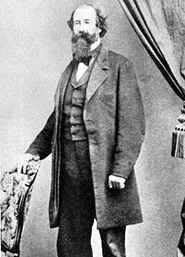The History of NorCal Names – How Redding Was Once Named ‘Reading’
Just 150 years ago, this area was known to the Gold Rush miners of the 1800's as Poverty Flats

Redding, California sits center stage in Northern California, nestled comfortably smack dab in the middle of the region. Called “the essence of California” by the San Francisco Chronicle, the town of Redding is known for its beautiful landscape and world-renown outdoor surroundings.
It was just 150 years ago that this area was known to the Gold Rush miners of the 1800’s as Poverty Flats. And after the railroad hub was built in the town, people didn’t know if they should call it Reading or Redding. In fact, the larger area of Shasta County was largely settled by two people, one named Reading and one named Redding.
The irony of the similarities in their names remains a great anecdote for the history of the area. They both lived amazing lives and both deserve credit for the settlement of Redding.
Pearson B. Reading

In 1844, the first official settlement was established in the area by Pearson Barton Reading, an early California pioneer who received a Mexican land grant for the 26,632 acre area that is now occupied by Redding and Cottonwood along the Sacramento River. At the time, it was the northernmost settlement in California.
Reading setup a gold mining operation just a few miles up Clear Creek, in the area near Whiskeytown Lake now called Old Shasta. As the area became a boomtown for gold miners, the area was aptly named Reading Springs, before eventually becoming the town of Shasta.
Pearson Reading went on to live a accomplished life, becoming a decorated Major in the Mexican-American War and leading an expedition to discover the bay into which he supposed the Trinity and Klamath Rivers emptied into. He even ran as a Whig candidate for the governor of California in 1851.
Reading passed away at his home in Shasta County in 1868 at the age of 51.
Benjamin B. Redding

In 1849, 25-year-old Candian go-getter Benjamin Bernard Redding sailed down to California looking for opportunity – and boy did he find it. By the ripe age of 29, he was elected California State Assembly for Yuba and Sierra Counties, beginning his political career that saw him serve as mayor of Sacramento and Secretary of State.
In 1868, Redding left his political career to become a land agent for the Central Pacific Railroad and purchased the perfect piece of land to put a railroad hub, six miles east of boomtown Shasta and right at the end of the Northern California valley before the railroad headed up into the mountainous region – Poverty Flats.
During the construction of the hub in 1872, the railroad built a town to accommodate the people traveling through the area. In honor of their land agent, the locals ditched the unflattering name of Poverty Flats and named the town Redding.
B.B. Redding went on to become a a member of the California Academy of Sciences and the California Fish Commissioner until he died in San Francisco at the age of 58. He is buried at the Sacramento Historic City Cemetery.
How Redding Decided on a Named

The town, previously known as Poverty Flats, was officially named Redding following the successful installation of the railroad hub and subsequent town. Nearly eight years later in 1874, local legislature lobbied to change the name to Reading, in honor of the man who had initially settled the area.
For six years, there was confusion as to the true name of the town. Some showed their loyalty to the man who initially settled the area, Reading, while others chose to honor the man who brought the riches of the railroad, Redding. Both names were pronounced the same, but nevertheless, the legacy of the town was at hand.
Ultimately, the Central Pacific Railroad won out, officially naming the town Redding in 1880 and incorporating the town in 1887.
The two men, Pearson Barton Reading and Benjamin Bernard Redding, will forever be linked in the same ilk in Northern California history. Two men with astoundingly similar names and astoundingly similar legacies, whose legacies will live on because of Redding, California.
